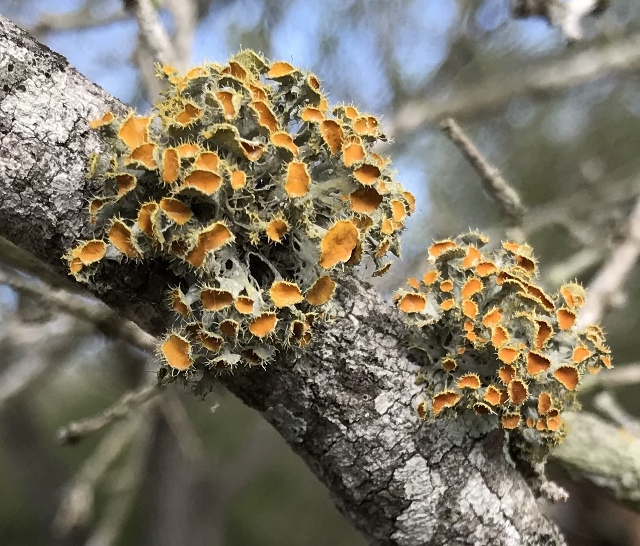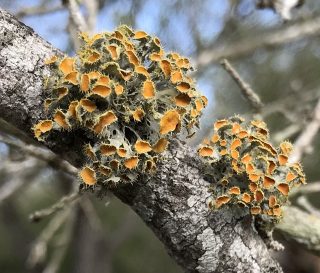
Story and photos by Anita Westervelt, Texas Master Naturalist
Lichens are unique organisms that have been around for about 400 million years. They are not plants, nor mosses. Lichens, defined biologically, are a complex life form that is a symbiotic (mutually beneficial) partnership of two separate organisms: a fungus and an alga.
Lichens do not have roots, stems or leaves; their chloroplasts, cells that convert light (energy) into chemical energy through photosynthesis, are contained only in the algae on the top surface of the lichen.
The right conditions for lichen growth are good air quality, habitat continuity, favorable climate and availability of preferred substrates.
The most common natural substrates are trees, rocks and soil, but nearly anything that doesn’t move can be a suitable substrate, like houses, tombstones, old cars and disused farm equipment. Each substrate must have the individual components in the right amounts in order for lichens to grow: water, air, light and nutrients. The main nutrients needed for growth are nitrogen, carbon, and oxygen. They won’t grow in heavy shade; they need sunlight for photosynthesis to provide food for themselves. Different lichens need different amounts of light.
When conditions are good, lichens will expand over the suitable substrate. The algae in the lichen produce carbohydrates and the fungi use that to grow and reproduce. Also, small pieces break off and are dispersed by the wind. Sometimes the fungal component of many lichens will produce spores and reproduce sexually.
Lichens live in a multitude of different habitats and climates and are found in many colors and sizes. The symbiotic relationship makes it possible for algae to live in those different climates and provides the algae a means to convert carbon dioxide in the atmosphere into oxygen through photosynthesis.
There are three forms of lichen: crustose, which is a flat type of growth; foliose, leaf-like but prostrate; and fruticose, which can be bush like and erect or a hanging growth. Historically, compounds unique to lichens have been used in perfume additives, fiber dyes, tanning agents, poisons and medicines in some countries.
One lichen prevalent in the Valley can often be seen on branches or limbs of the honey mesquite. It is Ramalina complanata lichen, a foliose, or leafy form that is typically grey to grey-green in color.

A more colorful lichen found in the Valley is golden-eye lichen, Teloschistes chrysophthalmus, also a fruticose lichen; it has branching lobes. Their sexual structures, the apothecia (spore-bearing structure), are bright-orange with spiny projections (cilia) situated around the rim. It can be found globally most often along coastal areas.
Lichens are not parasitic to trees, though heavy lichen growth may restrict gas exchanges from the limb and can block light from reaching the plant’s surface. Lichen growth can indicate that a tree has experienced stress that has weakened the tree which can encourage lichen development. Lichen growth can indicate a tree needs attention.
On the other hand, lichens growing on rocks may release chemicals which speed the deterioration of the rock into soil, a process that eventually promotes production of new soils.
– 30 –
These sites were useful in researching this article: discovermagazine.com, livescience.com, earthlife.net, nature.com and U.S. Department of Agriculture’s U.S. Forest Service (fs.usda.gov)


Leave a Reply